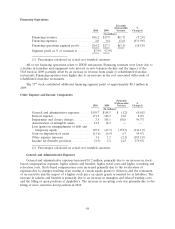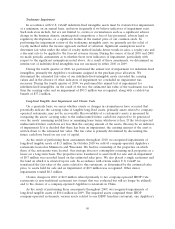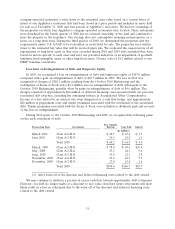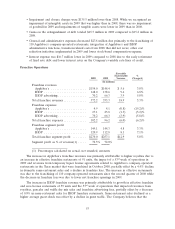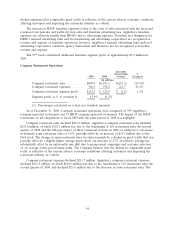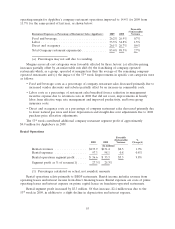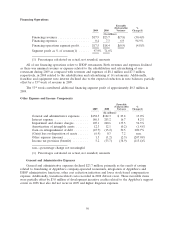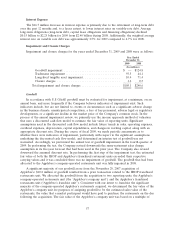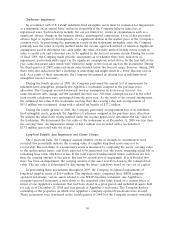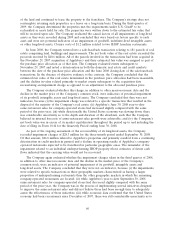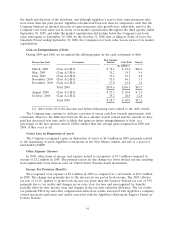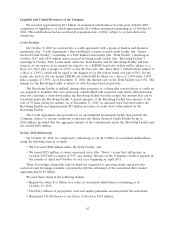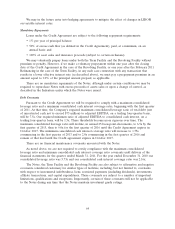IHOP 2010 Annual Report Download - page 73
Download and view the complete annual report
Please find page 73 of the 2010 IHOP annual report below. You can navigate through the pages in the report by either clicking on the pages listed below, or by using the keyword search tool below to find specific information within the annual report.
Interest Expense
The $16.7 million decrease in interest expense is primarily due to the retirement of long-term debt
over the past 12 months and, to a lesser extent, to lower interest rates on variable-rate debt. Average
long-term obligations (long-term debt, capital lease obligations and financing obligations) declined
$0.15 billion to $2.25 billion for 2009 from $2.40 billion during 2008. Additionally, the weighted average
interest rate on variable rate debt was approximately 2.5% for 2009 compared to 4.7% for 2008.
Impairment and Closure Charges
Impairment and closure charges for the years ended December 31, 2009 and 2008 were as follows:
Year Ended
December 31,
2009 2008
(In millions)
Goodwill impairment ................................ $ — $124.8
Tradename impairment ............................... 93.5 44.1
Long-lived tangible asset impairment ..................... 10.4 71.4
Closure charges .................................... 1.2 0.3
Total impairment and closure charges ...................... $105.1 $240.6
Goodwill
In accordance with U.S GAAP, goodwill must be evaluated for impairment, at a minimum, on an
annual basis, and more frequently if the Company believes indicators of impairment exist. Such
indicators include, but are not limited to, events or circumstances such as a significant adverse change
in the business climate, unanticipated competition, a loss of key personnel, adverse legal or regulatory
developments, or a significant decline in the market price of the Company’s common stock. In the
process of the annual impairment review, we primarily use the income approach method of valuation
that uses a discounted cash flow model to estimate the fair value of reporting units. Significant
assumptions used in the discounted cash flow model include future trends in sales, operating expenses,
overhead expenses, depreciation, capital expenditures, and changes in working capital, along with an
appropriate discount rate. During the course of fiscal 2009, we made periodic assessments as to
whether there were indicators of impairment, particularly with respect to the significant assumptions
underlying the discounted cash flow model, and determined an interim test of goodwill was not
warranted. Accordingly, we performed the annual test of goodwill impairment in the fourth quarter of
2009. In performing the test, the Company revised downwards the same-restaurant sales change
assumption in its five-year forecast that had been used in the prior year. The Company also revised
downward the assumed discount rate. In performing the first step of the impairment test, the estimated
fair value of both the IHOP and Applebee’s franchised restaurant units exceeded their respective
carrying values and it was concluded there was no impairment of goodwill. The goodwill that had been
allocated to the Applebee’s company-operated restaurants unit was fully impaired in 2008.
A significant majority of our goodwill arose from the November 29, 2007 acquisition of
Applebee’s; $10.8 million of goodwill resulted from a prior transaction related to the IHOP franchised
restaurants unit. We allocated the goodwill from the acquisition to two reporting units, the Applebee’s
company-operated restaurants unit (the ‘‘Applebee’s company unit’’) and the Applebee’s franchised
restaurants unit (‘‘Applebee’s franchise unit’’). Consistent with our intent to franchise the significant
majority of the company-operated Applebee’s restaurants acquired, we determined the fair value of the
Applebee’s company unit for purposes of assigning goodwill to be the estimated sales value of the
restaurants, the value that a market participant would have paid to purchase the restaurants on the day
following the acquisition. The fair value of the Applebee’s company unit was based on a multiple of
57



